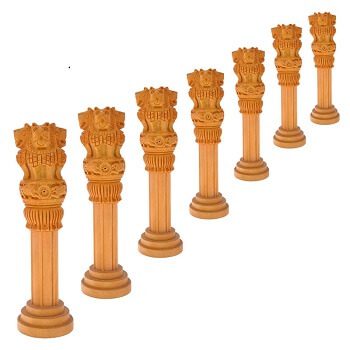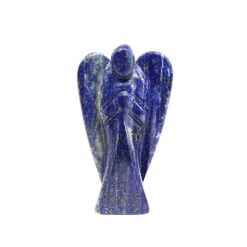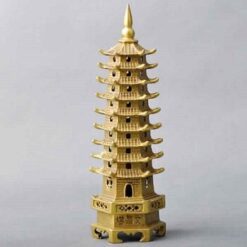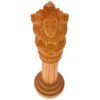Ashoka Stambh
From $10.60 Original price was: $10.60.$5.18Current price is: $5.18.
Delivery: Products are usually delivered in 2-6 days.
Offers: 5% off on Order Above Rs 2999. Code: VASTU
International Orders mail us on [email protected]
The Ashoka Stambh, or Ashokan Pillar, stands as a remarkable symbol of India’s ancient heritage, embodying profound historical, architectural, and symbolic significance. Erected during the Maurya dynasty in the 3rd century BCE under the patronage of Emperor Ashoka, these monumental columns are marvels of engineering and craftsmanship, each telling a story of imperial ambition, religious devotion, and cultural unity.
Historical Context and Origins
The Ashoka Stambh derives its name from Emperor Ashoka, who ascended the throne around 268 BCE following a period of warfare and conquest to expand the Mauryan Empire across most of the Indian subcontinent. Ashoka’s reign marked a pivotal moment in Indian history, not only for its territorial conquests but also for its transformation under the influence of Buddhism.
The pillars themselves were commissioned by Emperor Ashoka as part of his efforts to spread the teachings of Buddhism and proclaim his imperial edicts. These edicts, inscribed on the pillars in Brahmi script and Prakrit language, conveyed Ashoka’s principles of social welfare, religious tolerance, and moral conduct. The Ashoka Stambh served as both administrative markers and religious symbols, strategically placed in significant locations across the empire to disseminate Ashoka’s messages to a diverse populace.
Architectural Features and Design
The Ashoka Stambh is characterized by its distinctive architectural elements, which reflect the artistic and engineering achievements of the Mauryan period. Key features include:
- Monolithic Structure: Each pillar is carved from a single piece of stone, typically granite or sandstone, standing tall and imposing in various parts of the Indian subcontinent.
- Shaft and Capital: The pillar consists of a cylindrical shaft that tapers towards the top, often reaching heights of over 12 meters. At the summit of the shaft sits a capital, elaborately carved with animal motifs such as lions, bulls, elephants, and horses. These animals symbolize power, strength, and the diversity of the Mauryan empire.
- Inscriptions: The surface of the pillar shafts and capitals are inscribed with Ashoka’s edicts, written in Brahmi script and Prakrit language. These inscriptions provide invaluable historical insights into Ashoka’s governance, religious policies, and philosophical beliefs.
- Polished Finish: The pillars are notable for their smooth, polished surfaces, achieved through meticulous craftsmanship and technological expertise of the Mauryan artisans.
Symbolism and Religious Significance
The Ashoka Stambh holds profound symbolic and religious significance in Indian history and culture:
- Buddhist Iconography: The lion capital atop many of the Ashoka Stambh is particularly significant, as it represents the Buddha’s first sermon at Sarnath, where he expounded the principles of the Four Noble Truths and the Eightfold Path.
- Pillars of Dharma: Ashoka’s pillars were not merely architectural monuments but served as symbols of his commitment to promoting Dharma (righteousness) and ensuring the welfare of his subjects. They functioned as moral guides and reminders of ethical conduct for the empire’s inhabitants.
- Unity in Diversity: By incorporating diverse animal motifs and religious symbols on the capitals, the pillars underscored Ashoka’s vision of religious tolerance and cultural diversity within his empire. They conveyed a message of unity and coexistence among people of different faiths and backgrounds.
Spread and Preservation
Over the centuries, many of Ashoka’s pillars fell into disrepair or were vandalized, yet several have survived the ravages of time. Some of the most renowned Ashoka Stambh include those at Sarnath, where the famous lion capital is preserved and serves as the national emblem of India, and at Vaishali, where Ashoka convened the Third Buddhist Council.
Legacy and Influence
The legacy of the Ashoka Stambh extends beyond its historical and architectural significance:
- Cultural Heritage: As symbols of India’s ancient past, the Ashoka Stambh are cherished as cultural treasures that connect modern Indians with their illustrious heritage.
- Inspiration for National Symbols: The lion capital from the Ashoka Stambh at Sarnath was adopted as the emblem of independent India, symbolizing the nation’s commitment to justice, liberty, and equality.
- Architectural Inspiration: The design and craftsmanship of the Ashoka Stambh continue to inspire contemporary architects and artists, reflecting the enduring appeal of Mauryan aesthetics and engineering prowess.
The Ashoka Stambh stands as a testament to Emperor Ashoka’s visionary leadership, his embrace of Buddhism, and his commitment to ethical governance and social welfare. These monumental pillars, with their inscriptions and iconic animal capitals, encapsulate the ideals and achievements of the Mauryan Empire, leaving an indelible mark on India’s cultural and historical landscape. As symbols of unity, tolerance, and moral responsibility, the Ashoka Stambhs continue to inspire reverence and admiration, serving as enduring reminders of India’s ancient glory and enduring values.
| Dimensions | N/A |
|---|---|
| Size | 4 inches, 5 inches, 6 inches, 8 inches, 10 inches, 12 inches |
7 reviews for Ashoka Stambh
Add a review Cancel reply
Related products
All




























Rahul Sharma –
Seeing the intricate carvings and majestic lion capital atop the Ashoka Stambh at Sarnath evokes a deep sense of connection to India’s spiritual and philosophical roots.
Priya Patel –
smooth, polished surface of the Ashoka Stambh reflects the meticulous craftsmanship and technological prowess of the Mauryan artisans who created it.
Amit Singh –
I feel a sense of pride knowing that the lion capital from the Ashoka Stambh at Sarnath is India’s national emblem, representing our nation’s ideals of justice and unity.
Sneha Desai –
Meditating near the Ashoka Stambh helps me find inner peace and inspiration, connecting me with the timeless wisdom and compassion embodied in Buddhism.
Ravi Gupta –
I find solace in the symbolism of the Ashoka Stambh, which represents not only physical strength but also moral integrity and the pursuit of righteousness.
Meera Joshi –
I admire the Ashoka Stambh for its ability to transcend time and geography, bridging ancient wisdom with contemporary relevance in our modern world.
Raaj Malhotra –
Ashoka Stambh fills me with awe and reverence, standing as a monumental testament to India’s ancient heritage and cultural richness.